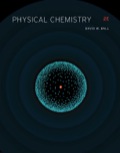
(a)
Interpretation:
The equation for Gibbs energy of mixing of gases is to be derived.
Concept introduction:
The term entropy is used to represent the randomness in a system. When a system moves from an ordered arrangement to a less ordered arrangement, then the entropy of the system increases. The entropy of mixing of gases is shown below.
Answer to Problem 4.62E
The equation for Gibbs energy of mixing of gases has been derived as shown below.
Explanation of Solution
The Gibbs free energy of mixing of gases is shown below.
Where,
•
•
•
•
The entropy of mixing of gases is shown below.
The change in Gibbs energy of the system is mathematically shown below.
Where,
•
•
•
•
The equation (3) can be written for the mixing process as shown below.
Assume that
Substitute the value of
Substitute the value of
Therefore, the equation for Gibbs energy of mixing of gases has been derived.
The equation for Gibbs energy of mixing of gases has been derived.
(b)
Interpretation:
The statement that the process of mixing of gases is always spontaneous is to be verified by a demonstration that the Gibbs free energy of mixing is always less than zero for a mixture of gases.
Concept introduction:
The Gibbs free energy of the system represents the maximum amount of non-expansion work achieved by a
Answer to Problem 4.62E
The mole fraction of gas is always less than one. The natural logarithm of a number that is less than one is always negative. Therefore, the value of change in Gibbs free energy for mixing of gas is always negative and the process is always spontaneous.
Explanation of Solution
The Gibbs free energy of mixing of gases is shown below.
Where,
•
•
•
•
The Gibbs free energy of mixing of two gases A and B can be given as shown below.
The mole fraction of both the gases is always less than one. The natural logarithm of a number that is less than one is always negative. The result of the addition of two negative values is also negative.
The right-hand side of the equation is negative for the mixing of gases.
Therefore, the negative value of change in Gibbs free energy indicates that the process of mixing of gases is spontaneous.
The mole fraction of gas is always less than one. The natural logarithm of a number that is less than one is always negative. Therefore, the value of change in Gibbs free energy for mixing of gas is always negative and the process is always spontaneous.
(c)
Interpretation:
The value of
Concept introduction:
The Gibbs free energy of the system represents the maximum amount of non-expansion work achieved by a thermodynamic system at isothermal and isobaric conditions. The change in Gibbs free energy is used to predict the spontaneity of the process. The Gibbs free energy of mixing of gases is shown below.
Answer to Problem 4.62E
The value of
Explanation of Solution
The number of moles of neon gas is
The number of moles of helium gas is
The number of moles of argon gas is
The temperature of mixing is
The temperature of mixing in Kelvin is shown below.
The total number of moles of gases is calculated as,
Where,
•
•
•
Substitute the value of
The mole fraction of a substance present in a system is shown below.
Where,
•
•
Substitute the value of the number of moles of neon gas and
Substitute the value of the number of moles of helium gas and
Substitute the value of the number of moles of argon gas and
The Gibbs free energy of mixing of gases is given as shown below.
Where,
•
•
•
•
Substitute the value of
Therefore, the value of
The value of
Want to see more full solutions like this?
Chapter 4 Solutions
EBK PHYSICAL CHEMISTRY
- The reaction Q(g) + R(g) → Z(l) is shown to be exothermic. Which of the following is true concerning the reactionarrow_forwardWhich of the following has the largest standard molar entropy, S° (298.15 K) He H2 NaCl KBr Hgarrow_forwardWhich of the following is true for a particular reaction if ∆G° is -40.0 kJ/mol at 290 K and –20.0 kJ/mol at 390 K?arrow_forward
- Choose the major product of the reaction with correct regio- and stereochemistry. Br2 H₂O O "Br Br & O 'Br OH Br 吡 O OH OH Br "OH Brarrow_forwardSelect the major product of the following reaction. & Br (CH)CONa (CH₂),COH 0 OC(CH) O &arrow_forwardDraw the products of the hydrolysis reaction between the ester molecule and water. Determine the products of the following reaction.arrow_forward
 Chemistry: Principles and PracticeChemistryISBN:9780534420123Author:Daniel L. Reger, Scott R. Goode, David W. Ball, Edward MercerPublisher:Cengage Learning
Chemistry: Principles and PracticeChemistryISBN:9780534420123Author:Daniel L. Reger, Scott R. Goode, David W. Ball, Edward MercerPublisher:Cengage Learning Physical ChemistryChemistryISBN:9781133958437Author:Ball, David W. (david Warren), BAER, TomasPublisher:Wadsworth Cengage Learning,
Physical ChemistryChemistryISBN:9781133958437Author:Ball, David W. (david Warren), BAER, TomasPublisher:Wadsworth Cengage Learning, Chemistry: The Molecular ScienceChemistryISBN:9781285199047Author:John W. Moore, Conrad L. StanitskiPublisher:Cengage Learning
Chemistry: The Molecular ScienceChemistryISBN:9781285199047Author:John W. Moore, Conrad L. StanitskiPublisher:Cengage Learning Principles of Modern ChemistryChemistryISBN:9781305079113Author:David W. Oxtoby, H. Pat Gillis, Laurie J. ButlerPublisher:Cengage Learning
Principles of Modern ChemistryChemistryISBN:9781305079113Author:David W. Oxtoby, H. Pat Gillis, Laurie J. ButlerPublisher:Cengage Learning Living By Chemistry: First Edition TextbookChemistryISBN:9781559539418Author:Angelica StacyPublisher:MAC HIGHER
Living By Chemistry: First Edition TextbookChemistryISBN:9781559539418Author:Angelica StacyPublisher:MAC HIGHER Chemistry & Chemical ReactivityChemistryISBN:9781337399074Author:John C. Kotz, Paul M. Treichel, John Townsend, David TreichelPublisher:Cengage Learning
Chemistry & Chemical ReactivityChemistryISBN:9781337399074Author:John C. Kotz, Paul M. Treichel, John Townsend, David TreichelPublisher:Cengage Learning





